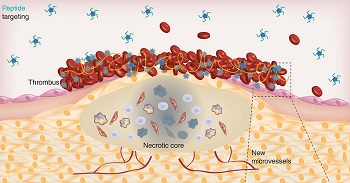 |
| Nanocarriers aimed at a necrotic core--Courtesy of Future Science |
Ischemic heart disease and stroke cause more than 17 million deaths annually. Drugs to treat the diseases can lead to intracranial hemorrhages and degrade in the bloodstream, requiring large dosages.
They can be improved by, you guessed it, enhanced drug delivery. A recent paper in Future Science provides an overview of clinical and preclinical nano- and microparticles and bubbles for carrying the drugs, with a goal of decreasing the rate of drugs' degradation in the blood and increasing the amount reaching the blood clot (or thrombus).
"This review outlines the preclinical research as well as the clinical trials made in this field. In spite of the encouraging results, more in-depth development is necessary to overcome the limits linked to thrombus deep localization, specific targeting of the clot and a rapid release of the drugs from safe nanoparticles," said paper author Didier Letourneur, of the federal French National Centre for Scientific Research, in a statement.
Here's a look at some of the different drug delivery options available to researchers:
- Lipid-based nanoparticles, such as microbubbles, are the only nanocarrier for the diseases that has been tested in clinical trials. When used in combination with ultrasound they've shown promise at improving the rate of recanalization, which improves blood flow by restoring the lumen. Poor stability in the blood flow is one drawback of these nanocarriers.
- Polymer-based nanocarriers are more resistant to mechanical constraints. In addition, various parameters can be modified, the paper says, such as size, porosity and hydrophobicity. They can also be functionalized to gain a charge or make a particle magnetic. Another strategy is drug encapsulation with the polymer. The polymer PGLA is already FDA-approved and used in medical research due to qualities like biodegradability and biocompatibility.
- Inorganic nanocarriers are primarily magnetic nanoparticles. They can be guided within the body using a locally applied magnet. Despite the name, these nanoparticles can be biodegradable.
Compared to therapeutic areas like cancer, nanocarriers have barely been deployed in the fight against clogged vessels that lead to stroke and heart disease. But this overview of development in the field shows that they have potential.
- read the entire paper
- here's a summary